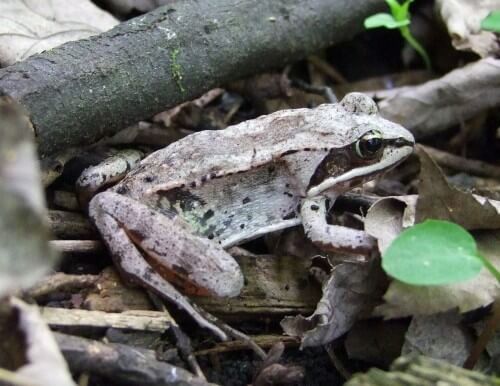The tree frog survives long and harsh winters in Canada and the northern United States, and can completely freeze, thaw, and return to activity numerous times without harm.

By: Maya Givon
The tree frog Lithobates sylvatica is a species of the frog family that is common in North America, and was even chosen as the national amphibian of the state of New York, an honorable title without a doubt. The unprecedented cold waves that hit the region recently caused a lot of damage, but the national frog apparently survived them without difficulty, as it has an unusual ability to cope with freezing temperatures.
Plants and animals have different strategies for dealing with cold. Many of them avoid it by migrating or by finding a hiding place for the winter, or they go into hibernation in a relatively warm place, and delay their life cycle until the return of favorable conditions for their existence. But there are also those who do not run away or hide, but endure the stagnation.
Dealing with low temperatures by resisting freezing is a complex strategy: when the temperature drops below zero, the water in the blood freezes and forms small ice crystals. These may cause damage to the blood vessels, damage the function of the cells and lead to dehydration. An animal that is able to freeze and thaw must be able to protect its body from these damages.
The tree frog survives long and harsh winters in Canada and the northern United States, and can completely freeze, thaw, and return to activity numerous times without harm. During the stasis, her tone changes from brown to bluish, core activity ceases, and up to 65% of the amount of water in her body becomes solid. All physical activity, including breathing, stops, the metabolism drops and so the glacier-frog spends the winter in suspended animation until the air warms up again.
How does she do it? Two mechanisms help the frog: the first is control and control over the freezing process. The frog is able to create proteins that encourage freezing, and actually initiates the start of freezing from a controlled source in its body, so it can control the process and slow it down, thus allowing the body to adapt to the situation more gradually than in spontaneous freezing, which can be extremely fast. The second mechanism includes the production of a substance that prevents freezing: the frog stores sugars in high concentration inside the cells, so that the water leaves the cells and leaves a concentrated sugar solution in them, which prevents freezing and damage. Only the space between cells freezes.
Biologists hypothesize that these strategies are actually a combination of the frogs' adaptation strategies to dry conditions. Most amphibians have skin that is extremely permeable to water and therefore they also lose water very easily. Frogs that live on land have the ability to lose up to 50% of the fluids in their body and recover - an ability that does not exist in vertebrates.
The exact mechanisms that allow the frog to freeze and recover are still being investigated, and many questions are still open: How does the animal survive for a long time without oxygen? What are the triggers that start the freezing process - and more importantly, the thawing process? The road to a full understanding of these puzzles is still long, but the potential uses that can develop as a result of them excite the imagination...

4 תגובות
A tree frog in Hebrew "Ilanit"
Ants are also able to survive freezing even down to minus 20
The patent is to first give them time to prepare by putting them in the refrigerator for several hours and then their body produces a protective substance
Then when they are ready to be frozen from trial about 80% will survive
Insects could theoretically survive in ice blocks launched to Earth-like stars.
If the ice block is over several kg it will melt upon entering the star's atmosphere while still in the air or on the ground and the insects will be released.
safkan
Why leave 2 cities? If it is a very long journey it is not practical. And in any case - all they can do is press the yellow button when the red light comes on.
Already today there is no real reason to fly passenger planes.
Interesting article, if true.
Interesting because there is a lot of talk about hibernation (initiated coma for several years) as a solution for manned space travel in the solar system. These journeys can continue for several years and in the meantime the astronauts will waste years of life without benefit. In this case hibernation stops the life process of most astronauts except for one or two who will remain awake. The use of hibernation is demonstrated in the movie "A Space Odyssey 2000".
In the more distant future hibernation may be used for additional purposes, but currently not relevant.